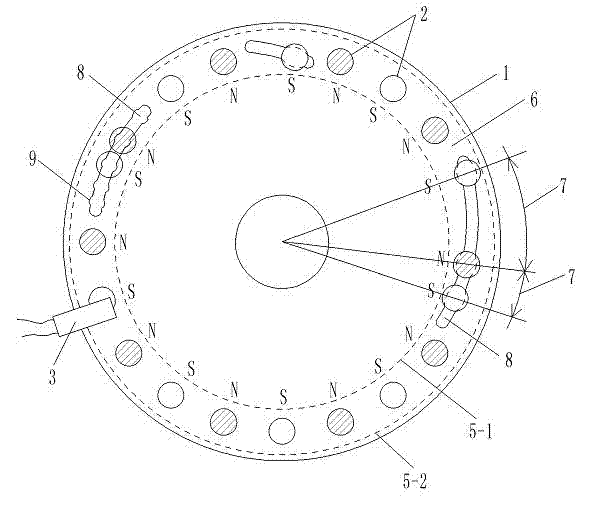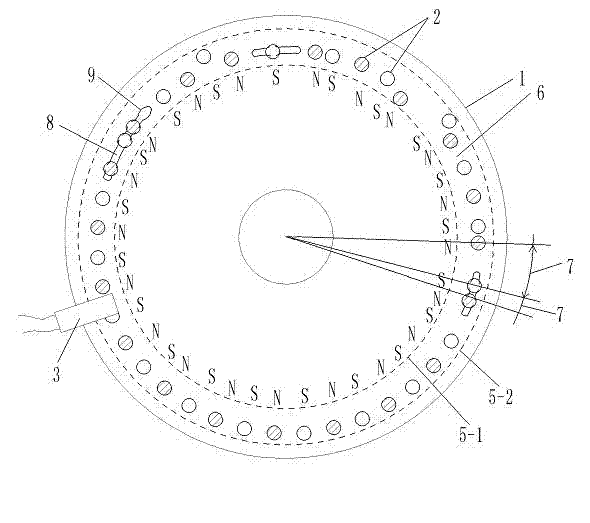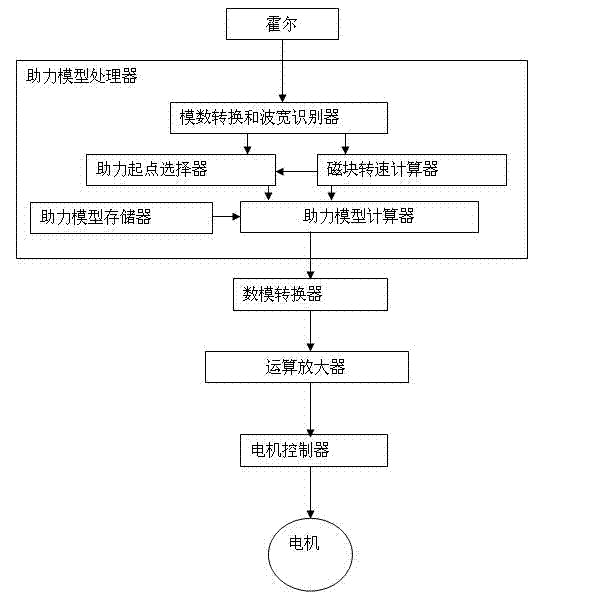Multi-magnetic block position-adjustable turntable sensor for assisted bicycle
An adjustable technology for power-assisted bicycles, which is applied in the direction of transmission of sensing components, vehicle components, riders, etc., using electric/magnetic devices, and can solve the problem of no control signal, incompatibility, and permanent magnets that cannot indicate pedal rotation Location etc.
- Summary
- Abstract
- Description
- Claims
- Application Information
AI Technical Summary
Problems solved by technology
Method used
Image
Examples
Embodiment 1
[0113] Embodiment 1. A turntable sensor with adjustable multi-magnet positions for power-assisted bicycles
[0114] Such as figure 1 , 3 , the sensor in this embodiment includes a sensor element connected in sequence, a booster model processor 21, a digital-to-analog converter 27 and an operational amplifier 28;
[0115] [1] The sensing element is an element that converts the rotational motion of the rotating disk 1 into a rectangular wave signal output;
[0116] The sensing element is to use a high-strength plastic rotating disk 1 with a diameter of 10.0 cm to set 20 permanent magnets 2 with a diameter of 0.8 cm on one surface, and the magnetic flux is 146---279 (B·H)max / KJ·m -3 a value in . The structure of rotating disk 1, permanent magnet block 2 and Hall 3 is as follows:
[0117] Each permanent magnet block 2 is fixed in the circular ring 6 range between the circular trajectory line 5-1-9.5 cm outer circular trajectory line 5-2 with a diameter of 8.0 cm, and there ...
Embodiment 2
[0134] Embodiment 2. A multi-magnet position-adjustable turntable sensor for high-density power-assisted bicycles
[0135] Such as figure 2 , 3 1. A high-strength aluminum rotating disk 1 with a diameter of 10.0 cm is provided with 40 permanent magnet blocks 2 with a diameter of 0.6 cm. The magnetic flux of the permanent magnet block 2 is 146---279 (B·H)max / KJ·m -3 A certain value, Hall 3 keeps a distance of 0.2 cm from each permanent magnet block 2 in the rotating state, so that when each rotating permanent magnet block 2 passes through Hall 3, Hall 3 can generate a corresponding Rectangular wave signal output. Other structures are the same as in Embodiment 1.
Embodiment 3
[0136] Embodiment 3, a turntable sensor with adjustable multi-magnet positions for power-assisted bicycles with specific circuits
[0137] Such as figure 1 , 4 , the sensor in this embodiment includes a sensor element connected in sequence, a booster model processor 21, a digital-to-analog converter 27 and an operational amplifier 28;
[0138] [1] The Hall 3 in the sensing element is UGN3075; the structure of other elements and elements in the sensing element is the same as that in Embodiment 1;
[0139] [2] The auxiliary model processor 21 selects the single-chip microcomputer 31 to complete all functions, and the single-chip microcomputer 31 selects AT89S52. That is, the AT89S52 single-chip microcomputer 31 completes all functions of the analog-to-digital conversion and the wave width identifier 22 , the power-assisted starting point selector 23 , the magnet speed calculator 24 , the power-assisted model memory 25 and the power-assisted model calculator 26 .
[0140] [3]...
PUM
 Login to View More
Login to View More Abstract
Description
Claims
Application Information
 Login to View More
Login to View More - R&D
- Intellectual Property
- Life Sciences
- Materials
- Tech Scout
- Unparalleled Data Quality
- Higher Quality Content
- 60% Fewer Hallucinations
Browse by: Latest US Patents, China's latest patents, Technical Efficacy Thesaurus, Application Domain, Technology Topic, Popular Technical Reports.
© 2025 PatSnap. All rights reserved.Legal|Privacy policy|Modern Slavery Act Transparency Statement|Sitemap|About US| Contact US: help@patsnap.com



